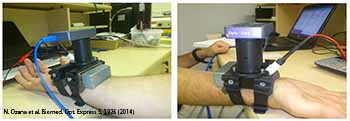
Optical configuration for remote measuring of glucose levels from the subject’s hand.
Among fitness enthusiasts, wearable, high-tech devices for tracking exercise levels and calorie consumption are all the rage. Simultaneously, health professionals need to monitor vital signs non-invasively in a growing number of patients.
Two research teams, one based in Israel and the other in the Netherlands, have built wearable devices to measure important medical parameters. The experimental devices (Biomed. Opt. Express 6, 1926 and 7, 2145) follow the changes in laser speckles reflected off a patient's skin.
The first group, led by Zeev Zalevsky of Bar-Ilan University (Ramat-Gan, Israel), constructed a watch-like device that aims laser pulses (wavelength 532 nm) at human skin near an artery and captures the backscatter in an electronic camera. The gadget measures the backscattered reflections in the presence of a magnetic field, which creates the well-known Faraday effect—rotation of the plane of polarization of light.
Changes in blood glucose concentration also alter the polarization states of the wavefront, according to the authors. Compared to other substances found in blood, glucose has a high Verdet constant—a wavelength-dependent number measuring the strength of the Faraday effect. The magnetic field allows the light to interact only with the glucose molecules and not other blood components.
The Bar-Ilan device—minus the magnet—measures dehydration levels without the need to take blood or urine samples from a patient during physical activity. The device needs some refinements—especially motion cancellation or some other way to keep it physically stable with respect to the patient's wrist—before it can face clinical evaluation.
The second team of researchers, led by Mahsa Nemati of the Delft University of Technology (Netherlands), studied speckle-imaging techniques for measuring a pulsed flow of liquid, such as blood, in an environment where the patient's motions induce signal artifacts. Nemati and her colleagues first analyzed laser-speckle imaging of a device with milk pulsing through simulated blood vessels.
Once they refined their spectral analysis, the scientists measured the pulse of a human volunteer who also wore a standard pulse oximeter for comparison. They found that just a few pixels from the device's camera were enough to yield a usable pulse measurement.
